China Merchants Bank (CMB) shrugged off a 1.64% year-on-year drop in revenue to Rmb339.1 billion ($46.9 billion), to post a 6.2% increase in after tax profit of Rmb146.6 billion, in its 2023 annual results, from January 1 to December 31 (FY 2023).
Profits were bolstered by a decline in operating expenses by around Rmb1 billion to Rmb121 billion in FY 2023, while impairment losses were Rmb41.5 billion in FY 2023, compared with Rmb57.6 billion in FY 2022.
The majority of CMB’s revenue, Rmb268.2 billion in FY 2023, comes from interest income from loans, and this figure reduced by 1% compared with FY 2022. The average loan yield reduced across corporate, retail and discounted bills when compared with FY 2022, while interest accrued from group investments declined 22.8% to Rmb80.4 billion in FY 2023.
Traditionally strong within China’s retail segment, the Chinese giant was impacted by the country’s weak property sector – with the non-performing corporate loans ratio for property development reaching 5.26%, up from 4.08% in the last financial year, amounting to a sum of Rmb17.2 billion. The total amount of non-performing corporate loans was worth Rmb31 billion.
Such an increase in non-performing loans was attributed to the “risk exposure of high-debt real estate enterprises and individual corporate customers with poor operation and management”, a March 25 report from CMB noted.
As a result, the bank is trying to move towards more quality property developments.
“The group seized structural opportunities, focused on high-quality enterprises and high-quality regions, and selected high-quality businesses and projects that can be covered by project cash flow, especially high-quality commodity residential projects, government-subsidised (rental) housing projects and operating property projects,” the report said.
Margins tighten
Economic and regulatory tailwinds have weighed on the bank’s revenue in Q1 2024, and the bank is expecting such pressures to continue across the year, CMB’s board members said at a press conference in Hong Kong.
One of the reasons is that the five-year loan prime rate (LPR) was cut by the People’s Bank of China (PBOC) from 4.2% to 3.95% in February. The largest cut of the benchmark lending rate in history, which also ended a five-month unchanged rate level, has been seen as the central government’s key measure to help ease pressure in the property sector.
For Chinese banks, interest received from retail mortgage loans is set to decrease significantly. Fitch Ratings has estimated that this will result in a narrowing of banks’ average net interest margin (NIM) by six basis points (bp) over 2024 and 2025, equivalent to around 5% of overall net profits. State-owned banks will see a more significant impact because of their proportionately higher exposure to mortgages and infrastructure loans, said Fitch.
A reduction in insurance commission fees by the National Financial Regulatory Administration in China is also set to hit CMB’s profits this year.
Jiawen Peng, executive vice president, chief financial officer (CFO), and secretary of the board of directors, CMB, said during the press conference that combined with a low demand for new mortgage loans, the bank is predicting continued pressure on its revenue from the retail side, as regulatory measures continue to bite.
Jianmin Miao, chairman of CMB, said that it “could be challenging” for the bank to sustain its strong profit growth in Q1, mainly due to an imbalance between capital supply and borrowing demand.
CMB is based in Shenzhen, Guangdong province. It is one China’s largest commercial banks and is listed on the Shanghai Stock Exchange and Hong Kong Stock Exchange.
The bank’s return on average assets (ROAA) was 1.39%, with the return on average equity (ROAE) at 16.22%. Both figures decreased by 0.03% and 0.84% respectively compared to FY 2022, according to a March 26 announcement.
The dividend per share climbed to Rmb1.972 for FY 2023, compared with Rmb1.783 in FY 2022.
¬ Haymarket Media Limited. All rights reserved.







































.jpg&h=630&w=1200&q=100&v=0ad411d9a2&c=1)